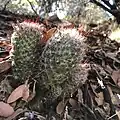Cochemiea wrightii
| Cochemiea wrightii | |
|---|---|
.jpg)
| |
| Scientific classification | |
| Kingdom: | Plantae |
| Clade: | Tracheophytes |
| Clade: | Angiosperms |
| Clade: | Eudicots |
| Order: | Caryophyllales |
| Family: | Cactaceae |
| Subfamily: | Cactoideae |
| Genus: | Cochemiea |
| Species: | C. wrightii
|
| Binomial name | |
| Cochemiea wrightii (Engelm.) Doweld 2000
| |
| Synonyms | |
| |
Cochemiea wrightii is a species of Cochemiea found in Mexico and the southern United States.[2]
Description
Cochemiea wrightii grows as a solitary cactus with dark green, flattened, spherical to briefly cylindrical shoots measuring 3 to 8 cm (1.2 to 3.1 in) in diameter. The cylindrical warts do not produce milky juice, and the axillae are bare. It has up to 3 dark, hooked central spines, each 1 to 1.2 cm (0.39 to 0.47 in) long. There are also up to 12 whitish marginal spines, 8 to 12 millimeters long, with the upper ones being shorter and dark-tipped.
The flowers are magenta to bright purple, rarely white, and up to 2.5 cm (0.98 in) long and wide, with perianth segments that are reflexed. The egg-shaped to spherical fruits are purple, up to 2.5 cm (0.98 in) long, and contain black seeds.[3]
-
.jpg) Fruit
Fruit -
_(7207721662).jpg) Flower
Flower
Distribution
Cochemiea wrightii is found in the US states of Arizona and New Mexico, and in the Mexican states of Sonora and Chihuahua at elevations of 1,000 to 2,200 m (3,300 to 7,200 ft). Plants are found growing in sandy hills and grasslands growing among Echinocereus polyacanthus and Cochemiea saboae subsp. haudeana.[4]
Subspecies
Accepted subspecies:[5]
| Image | Name | Distribution |
|---|---|---|
 |
Cochemiea wrightii subsp. wilcoxii (Toumey ex K.Schum.) Doweld | Arizona to New Mexico and Mexico (Sonora, Chihuahua) |
 |
Cochemiea wrightii subsp. wrightii | Arizona to Texas |
Taxonomy
The species was first described as Mammillaria wrightii by George Engelmann in 1856.[6] The specific epithet honors American botanist Charles Wright, who researched Texas and Cuba.[7] In 2000, Alexander Borissovitch Doweld reclassified the species into the genus Cochemiea.
References
- ^ Univ., Martin Terry (Sul Rose State; College, Kenneth Heil (San Juan; Mexico, New; Ambiental), Rafael Corral-Díaz (Consultor (2009-11-17). "The IUCN Red List of Threatened Species". IUCN Red List of Threatened Species. Retrieved 2024-06-02.
- ^ "Cochemiea wrightii (Engelm.) Doweld". Plants of the World Online. Retrieved 2024-04-21.
- ^ Anderson, Edward F. (2011). Das große Kakteen-Lexikon (in German). Stuttgart (Hohenheim): Ulmer. p. 415. ISBN 978-3-8001-5964-2.
- ^ "Cochemiea wrightii". LLIFLE. 2013-08-04. Retrieved 2024-06-17.
 This article incorporates text from this source, which is available under the CC BY-SA 3.0 license.
This article incorporates text from this source, which is available under the CC BY-SA 3.0 license.
- ^ "Cochemiea wrightii Pfeiff". Plants of the World Online. Retrieved 2025-07-02.
- ^ Schumann, Karl Moritz; Hirscht, Karl. (1899). Gesamtbeschreibung der Kakteen (Monographia cactacearum) /von Karl Schumann. Neudamm [Dębno, Poland?]: J. Neumann. doi:10.5962/bhl.title.10394.
- ^ Arts, American Academy of (1852). "Proceedings of the American Academy of Arts and Sciences". Metcalf and Co. ISSN 0199-9818. Retrieved 2024-06-17.
External links
 Media related to Cochemiea wrightii at Wikimedia Commons
Media related to Cochemiea wrightii at Wikimedia Commons Data related to Cochemiea wrightii at Wikispecies
Data related to Cochemiea wrightii at Wikispecies
